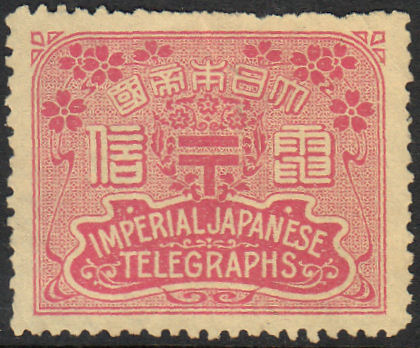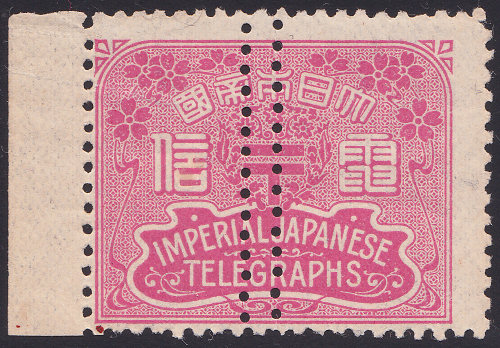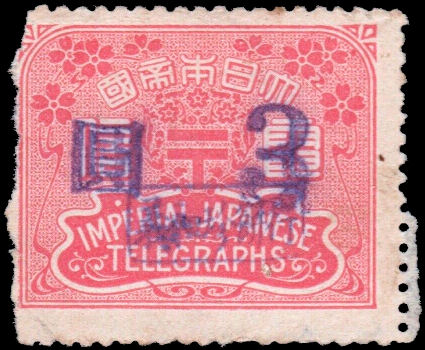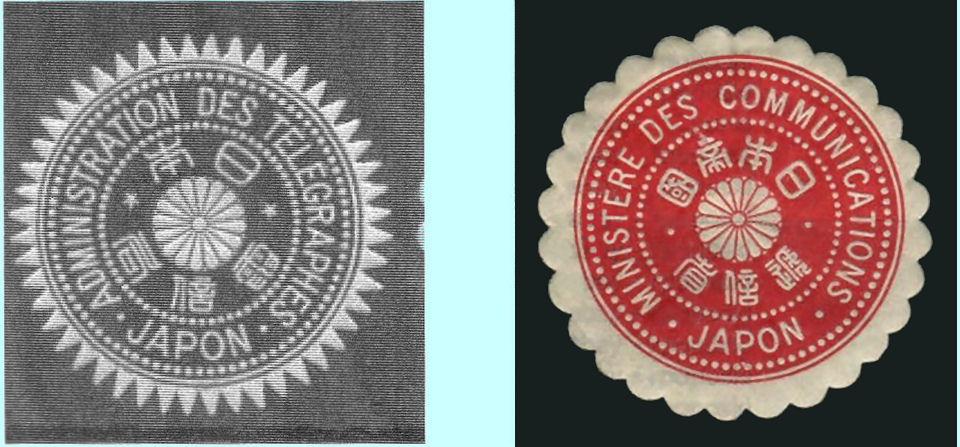JAPAN
Japan is one of the very few countries for which published information exists.
Seals are found sealing both envelopes and folded telegrams but #s 2, 3, 5 and 6 are more common mint.
| Updates. The above was written by Steve Hiscocks. I have re-arranged and re-ordered in light of new information using 'RH' (Revised Hiscocks) numbers. No pricing as yet. |
| Up until now I have had problems replacing Hiscocks' original black and white images with ne colour images.
I have now found out that those appear to have come from the Japanese Revenue Stamp Catalogue. the English name for the book is given as "Narumi's Japanese Revenue Stamp Catalogue", edited by Stephen Hasegawa. The 6th edition was 2016 (ISBN978-4-86355-051-3), but the 7th edition is available through several sellers on Ebay. I do not expect that I will be able to use the catalogue images, but until I have better, I will attempt to colourize the old images appropriately. |
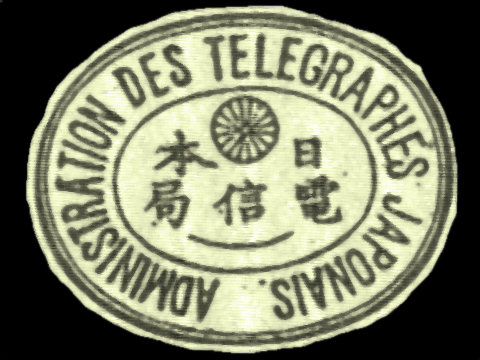 |
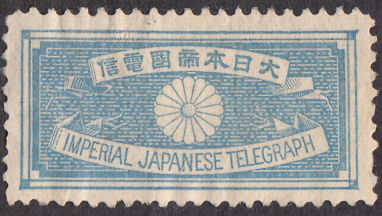 |
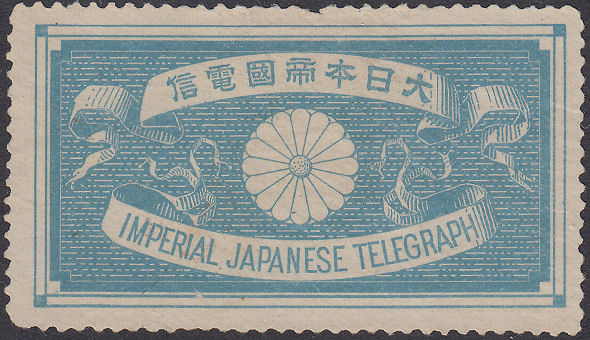 |
| #1 1889 - 日 本 / 電 信 局 (Telegraph Bureau) | #2 1889, 28.3mm |
#3 1890-96, 45mm., sheets of 5 x 10. |
| RH # | Type. | was | Description | Mint | Used | On telegram |
|---|---|---|---|---|---|---|
| RH1 | 1 | 1 | 1889 Die-cut oval. Blue. | - | - | - |
| RH2 | 2 | 2 | 1889, Blue (slight shades) Perf. 13 | - | - | - |
| RH2a | Perf. 13½ | - | - | - | ||
| RH2b | Perf. 14 | - | - | - | ||
| RH3 | 3 | 3 | 1890-96 Blue (shades) Perf. 11½ | - | - | - |
| RH3a | Perf. 12 x 11¾ | - | - | - | ||
| RH3b | Perf. 13 | - | - | - | ||
| RH3c | Perf. 13½ | - | - | - |
Japanese Postal Service (logo =  ).
).
5 characters at the top.
大日本帝國 (written stylized right to left) = Great Japanese Empire
電信 (written stylized right to left) = telegraphs
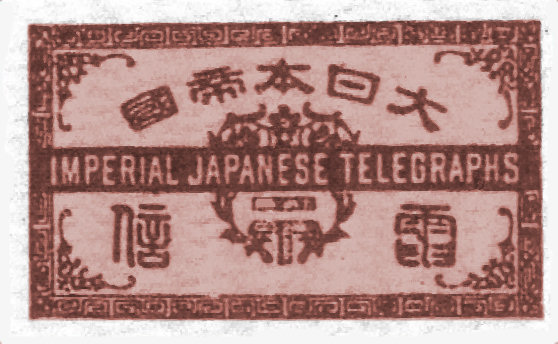 |
| #4 1903 |
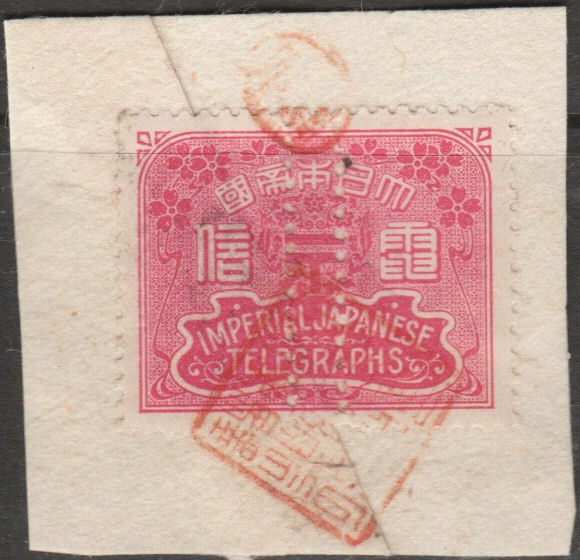 |
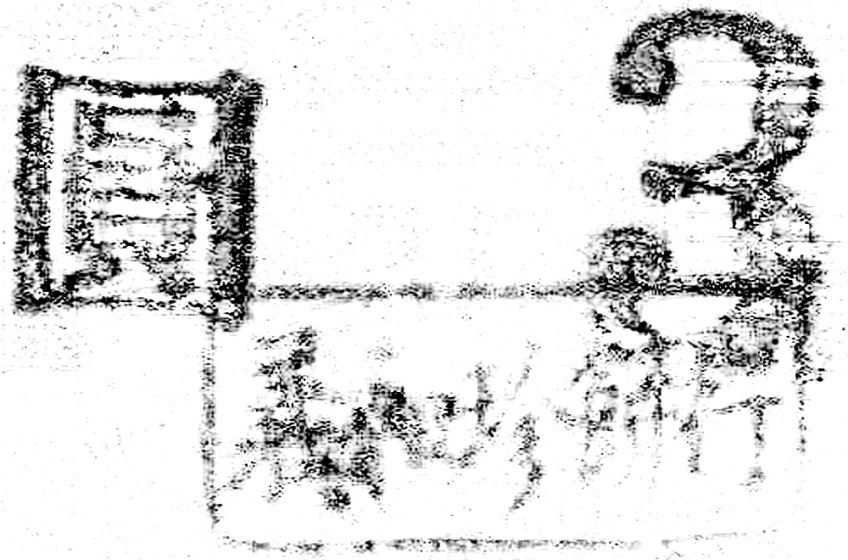 |
| #5a a used example The rows of holes are wider apart than on the above example. (click for listing) |
An enhancement of the overprint on H5b above. 義和診所行 ? |
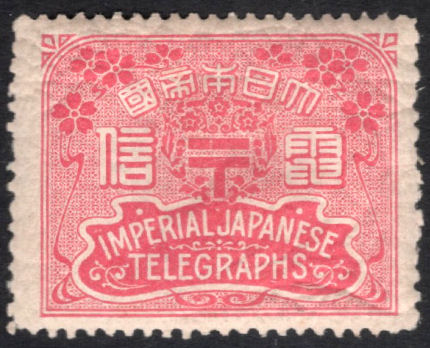 |
 |
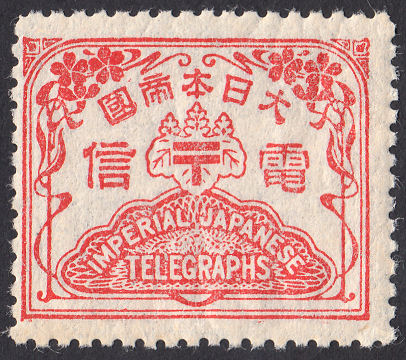 |
 |
| #5c Perf. 12½ x 11¾ | #6 1911-28, 39mm, sheets of 5 x 10. | #7 29.5mm | #7a 29.5mm |
Notes:
#7 is sometimes described as for use in Korea and I have now seen a couple on telegrams used in Korea in 1912 and 1917.
It is possible that they were also used in Japan though. The design around the ![]() symbol on #7 represents the seal of the Japanese Government.
symbol on #7 represents the seal of the Japanese Government.
These all include 'Imperial' so I would expect them to have been prepared before the end of WWII.
The use of 'Imperial' was dropped after WWII.
| RH # | Type. | was | Description | Mint | Used | On telegram |
|---|---|---|---|---|---|---|
| RH4 | 4 | 4 | 1890 Red. Perf. 11½ | - | - | - |
| RH5 | 5 | 5 | 1890-1915 Red. Perf. 11¾ | - | - | - |
| RH5a | With central perforations (Perf. 11¾ x 11½) | - | - | - | ||
| RH5b | Overprinted 3 Yen and boxed script. | - | - | - | ||
| RH5c | Perf. 12½ x 11¾ | - | - | - | ||
| RH6 | 6 | 6 | 1911-28 Red. Perf. 11½. | - | - | - |
| RH7 | 7 | 11 | 1912-17? Red. Perf. 10.8 | - | - | - |
| RH7a | Orange. | - | - | - |
4 characters at the top, reducing to 3 after WWII.
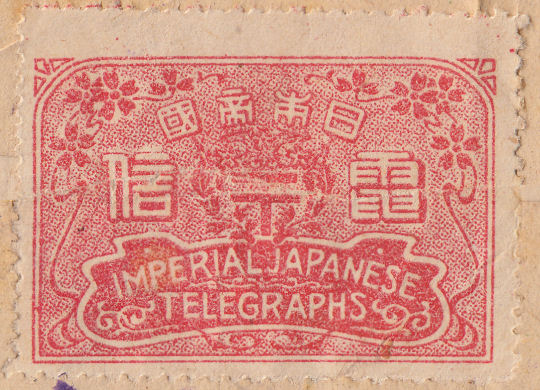 |
| #8 1949, 39.1mm., sheets of 5 x 10. |
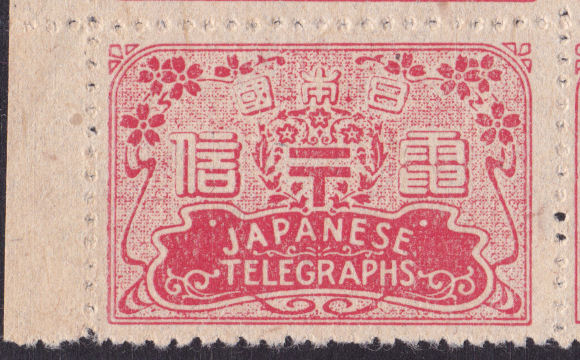 |
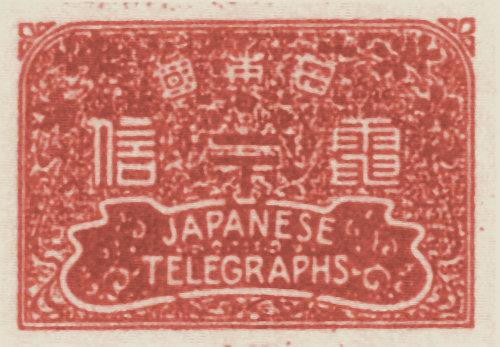 |
| #9 36mm | #10 1946 |
Note: The only example I have seen of #8 appears to have been genuinely used on a 1949 Telegram.
This seems rather late for an Imperial seal, I think they must have begun use during or before 1945.
#9 differs from #10 in the extent of the floral pattern each side of 'JAPANESE'.
| RH # | Type. | was | Description | Mint | Used | On telegram |
|---|---|---|---|---|---|---|
| RH8 | 8 | 7 | 1949, Red. 'Imperial Japanese Telegraphs'. Perf. 11½ 4 characters at the top. |
- | - | - |
| RH9 | 9 | - | 1946? Red. 'Japanese Telegraphs'. Perf. 10 ½ 3 characters at the top. |
- | - | - |
| RH10 | 10 | 8 | 1946? Red. 'Japanese Telegraphs'. Perf. 9½ 3 characters at the top. |
- | - | - |
Nippon Telegraph and Telephone Public Corporation. 1952-85

電報 (written stylized) = telegram
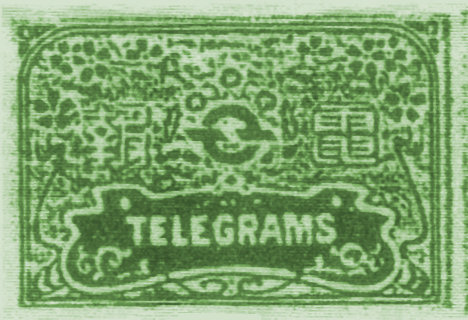 |
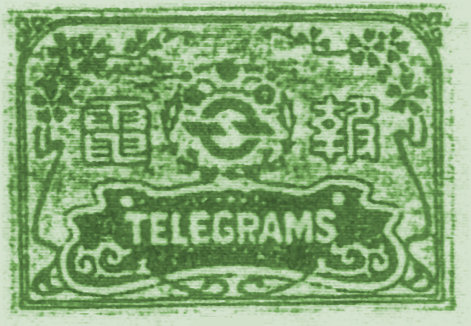 |
| #11 1949, sheets of 5 x 10. | #12 1950, sheets of 5 x 10. |
Hiscocks Types #9, #10 and #11 from page 39 of his book.
| RH # | Type. | was | Description | Mint | Used | On telegram |
|---|---|---|---|---|---|---|
| RH11 | 11 | 9 | 1949 Green. Perf. ? | - | - | - |
| RH12 | 12 | 10 | 1950 Green. Characters reversed (Westernised). Perf. 10 | - | - | - |
| RH12a | Perf. 11 | - | - | - |
The Manchurian Telegraph and Telephone Company (满洲電信電話株式會杜) 1933-45
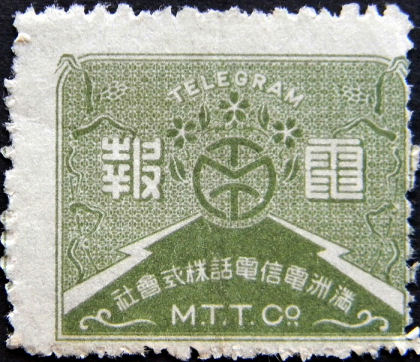 |
| #13 1938? 30mm. M.T.T.Co. I have only seen this on one telegram used in Tientsin (Tianjin, 天津) on the coast west of Manchuria and south-east of Beijing in July 1938 during the Japanese invasion of the Second Sino-Japanese War. |
| RH # | Type. | was | Description | Mint | Used | On telegram |
|---|---|---|---|---|---|---|
| RH13 | 13 | - | 1938? Rough perf. 11½. Olive green on white. No gum. | - | - | - |
電信烏替 = Telecommunications
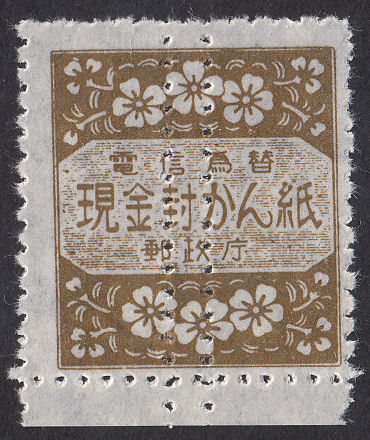 |
| #14 24mm, 1950? 電信烏替 = Telecommunications 現金封かん紐 = Cash Sealing String ?? 郵 政 庁 = Post office. There are very similar ones without the 電信 described as Ryukyu Islands Cash Registration Seals. Can anyone help on this? |
| RH # | Type. | was | Description | Mint | Used | On telegram |
|---|---|---|---|---|---|---|
| RH14 | 14 | - | 1952? Pin perf. 10.3 Grey-brown. | - | - | - |
Military Telegraph Seals
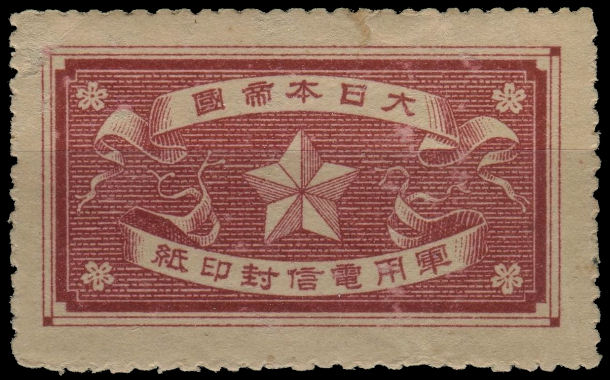 |
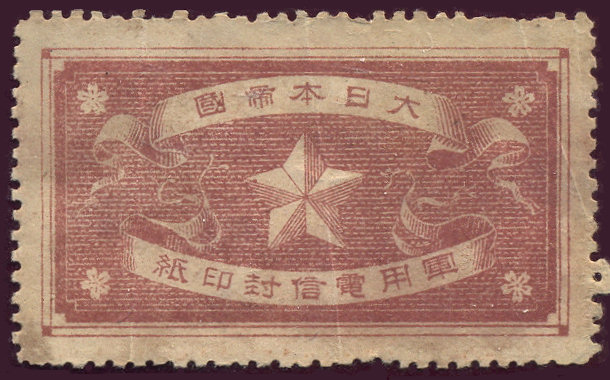 |
| #15, RH15a and RH15b 1896 (perf 10½, shadow on right side of top star segment), sheets of 5 x 2. | |
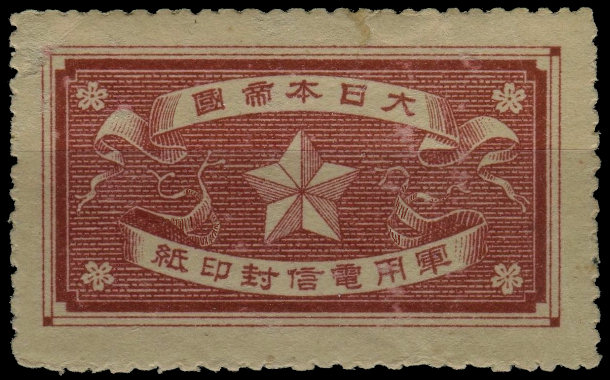 |
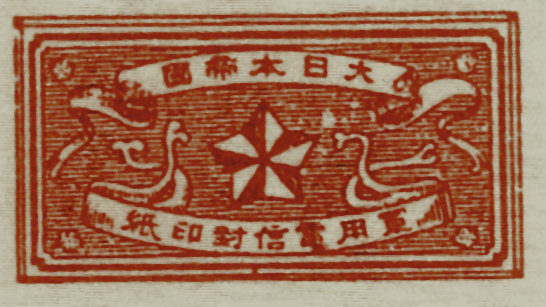 |
| #16 1896 (shadow on right of top star segment,
side "tendrils" more heavily shaded. This is a Mockup - proper image needed. |
#17 RH17a, 1937 (shadow on left side of top star) sheets of 5 x 2. |
| RH # | Type. | was | Description | Mint | Used | On telegram |
|---|---|---|---|---|---|---|
| RH15 | 15 | 12 | 1896, Plum, imperf | - | - | - |
| RH15a | 1896, Brown, perf 10½ | - | - | - | ||
| RH15b | 1896, Lighter brown. | - | - | - | ||
| RH16 | 16 | - | 1896 Red-brown, perf 12 | - | - | - |
| RH17 | 17 | 13 | 1937 Yellow-brown, perf 9 | - | - | - |
| RH17a | Red-brown, perf 10½ | - | - | - |
Hiscocks adds the following 2 notes:
| Note 1. There are three types of #12 distinguishable by the shading to the left on the lower scroll. These seals have been reported but mainly in Japanese and further explanation is needed. |
| Note 2. The two seals or labels below appeared in a lot on eBay in late 2006. They look as if they could be telegraph seals but more information is needed. |
My Notes: On his note 1, he had it a bit wrong. There are 3 different designs, I am missing one of them.
There is also some variation in colours and perforation.
On his note 2, the Japanese basically says the same as the French, #18 was indeed used as a seal.
| RH # | Type. | was | Description | Mint | Used | On telegram |
|---|---|---|---|---|---|---|
| RH18 | 17 | - | Telegraph Administraction. | - | - | - |
| RH18 | 19 | - | 1895. Ministry of Communications - red | - | - | - |
Other
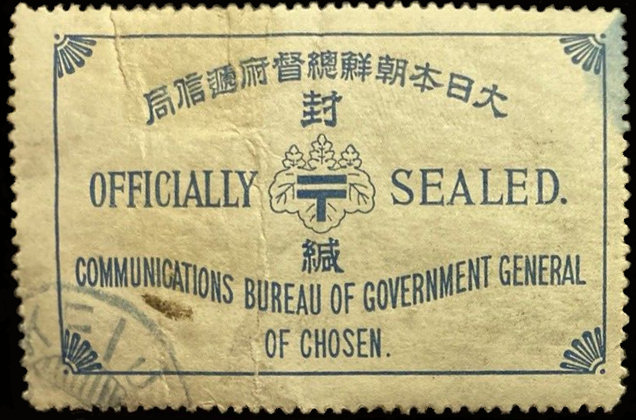
This is clearly a seal, but I do not know if it was used on telegrams (about 50mm)
大 日 本 朝 鮮 緦 督 府 遞 信 局 = Delivery Bureau of the Governor's Office of the Republic of Korea, Greater Japan
朝 鮮 = North Korea; 封 緘 = Seal
At the bottom is :
"Communications Bureau of Government General of Chosen."
The governor-general of Chōsen was established shortly after the Korean Empire was formally annexed by the Empire of Japan in the Japan–Korea Treaty of 1910.
This was used in Keij, now called Seoul.
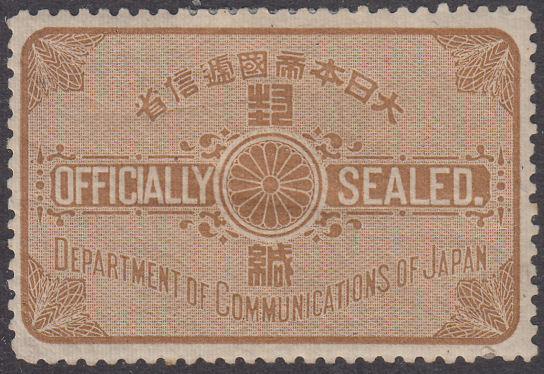
This is clearly a seal, but I do not know if it was used on telegrams (42.3mm, Perf.11¾)
大 日 本 帝 國 逓 信 省 = Ministry of Communications, Empire of Japan
封 緘 = Seal
NOT Telegraph Seals
A variety of seals exist marked, in varying degrees of legibility with :
Additionally they are perfinned with a series of the Postal Service logo ![]() sideways.
sideways.
Some are also stamped with a large red 免 = Free / Exemption or 無 = Nothing.
There appears to be no indication that these were intended for Telegraphic use.
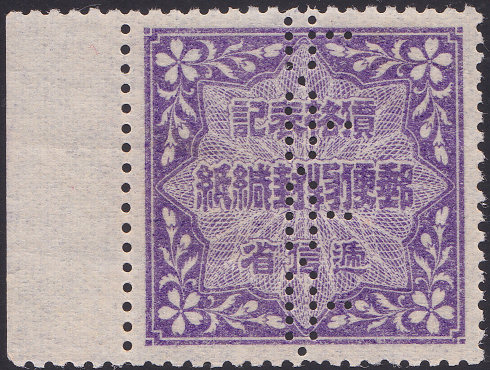 |
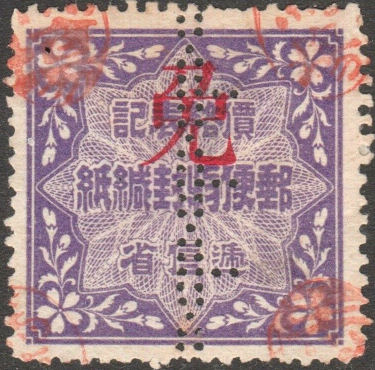 |
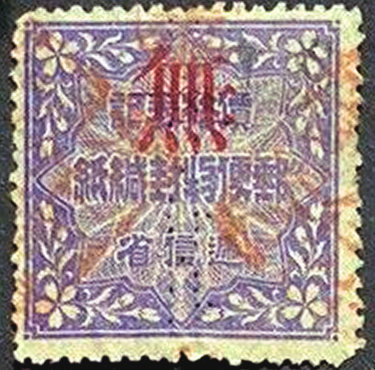 |
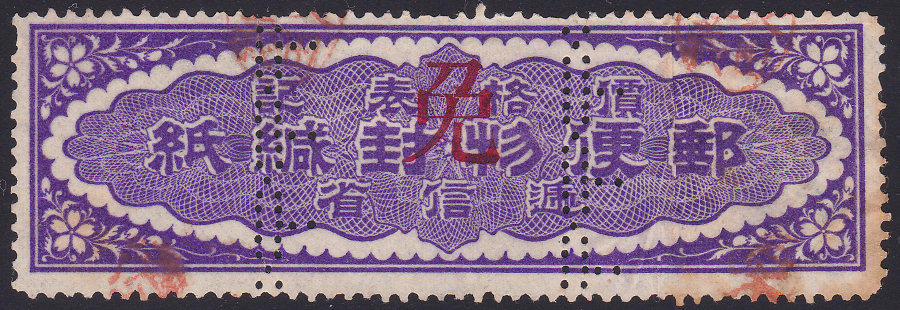 |
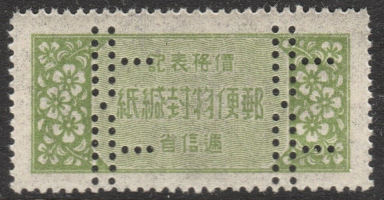 |
Telegram seals were initially used to seal folded telegrams. later the telegrams were sometimes put into envelopes and the seal applied to the envelope flap.
Telegram Seal Usage
Care is needed when deciding the year of a Japanese Telegram, particularly early ones.
Unfortunately, you need to know the date of it (roughly) to work out the date of the cancel !
Originally the numbers would be in Japanese Characters reading right to left, with the year according to the Meiji calendar.
This was the year of the Emperors reign and from 1868 to 1911 needed 1867 added to it to get the Western date.
| Era | from | to | range | Add |
|---|---|---|---|---|
| Meiji | 1868 | 1911 | 1 to 44 | 1867 |
| Taisho | 1912 | 1925 | 1 to 14 | 1911 |
| Showa | 1926 | 1988 | 1 to 63 | 1925 |
| Heisei | 1989 | 2019 | 1 to 31 | 1988 |
| Reiwa | 2020 | current | 1 to 2 | 2019 |
Later the date used Western numbers but with the rest unchanged.
At some stage the dates were given in American format (1940s?), and at some stage the Western calendar was used (by 1949) .
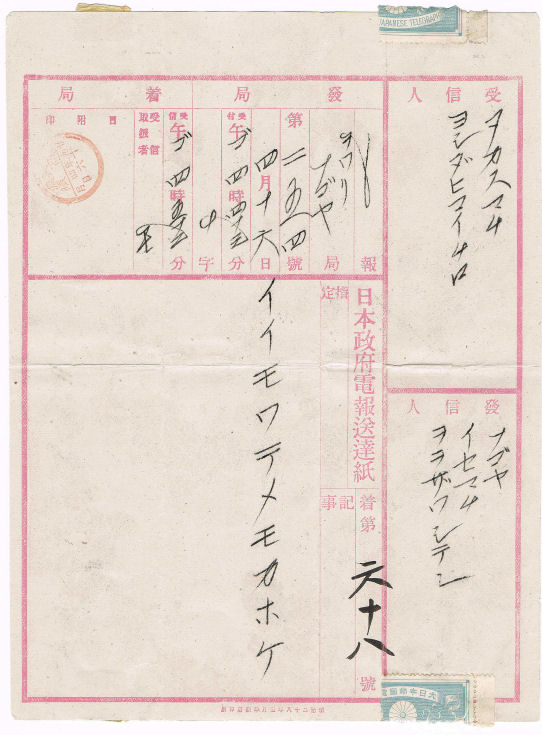
A form used in 1896.
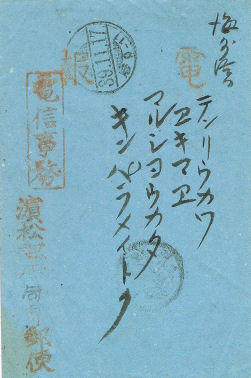
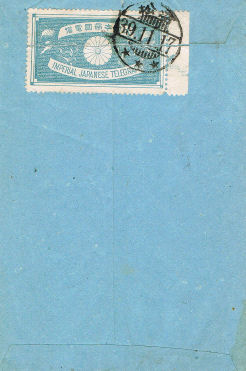
A 1906 envelope - front and rear.
The year on the cancel is 39 (the date is in year, month, day order). this is the meiji year. Add 1867 to get the year by the Western calendar.
The cancel on the seal was presumably to make it hard for a seal to be removed for access then replaced by another.
The meiji period ended 30 July 1912, when the Taishō period began (until 25/12/26), requiring the addition of 1912 to the dates.
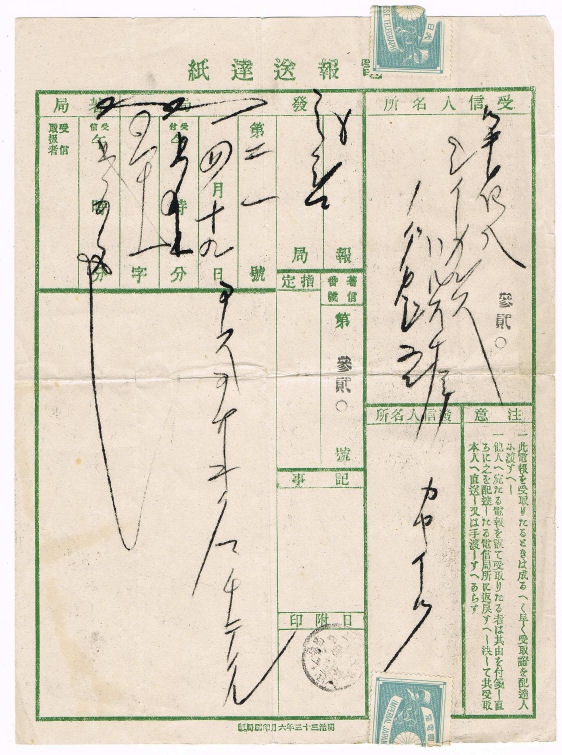
A form used in 1908.
If anyone can provide scans to help with this, I am happy to give appropriate credit.


